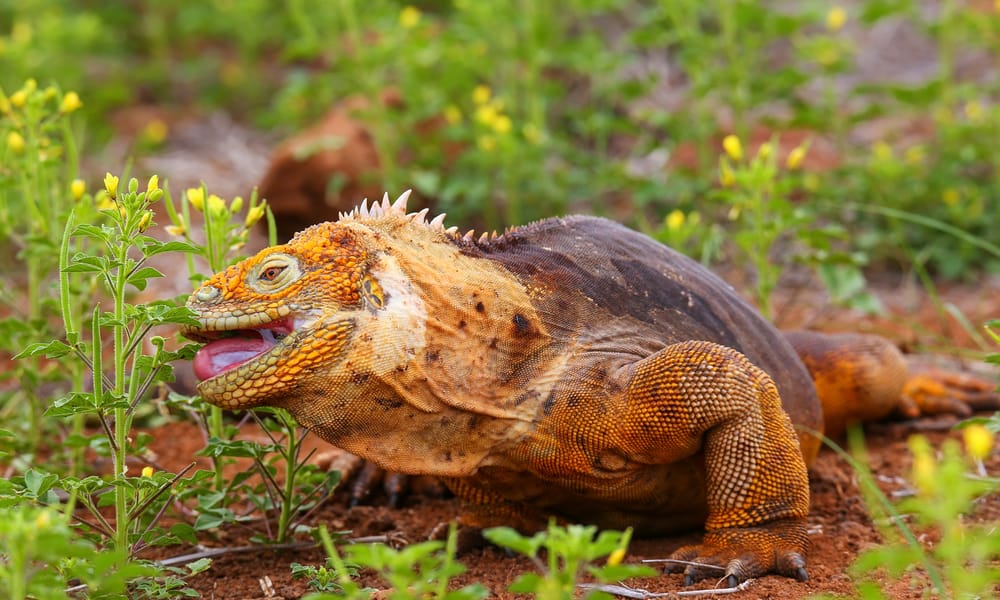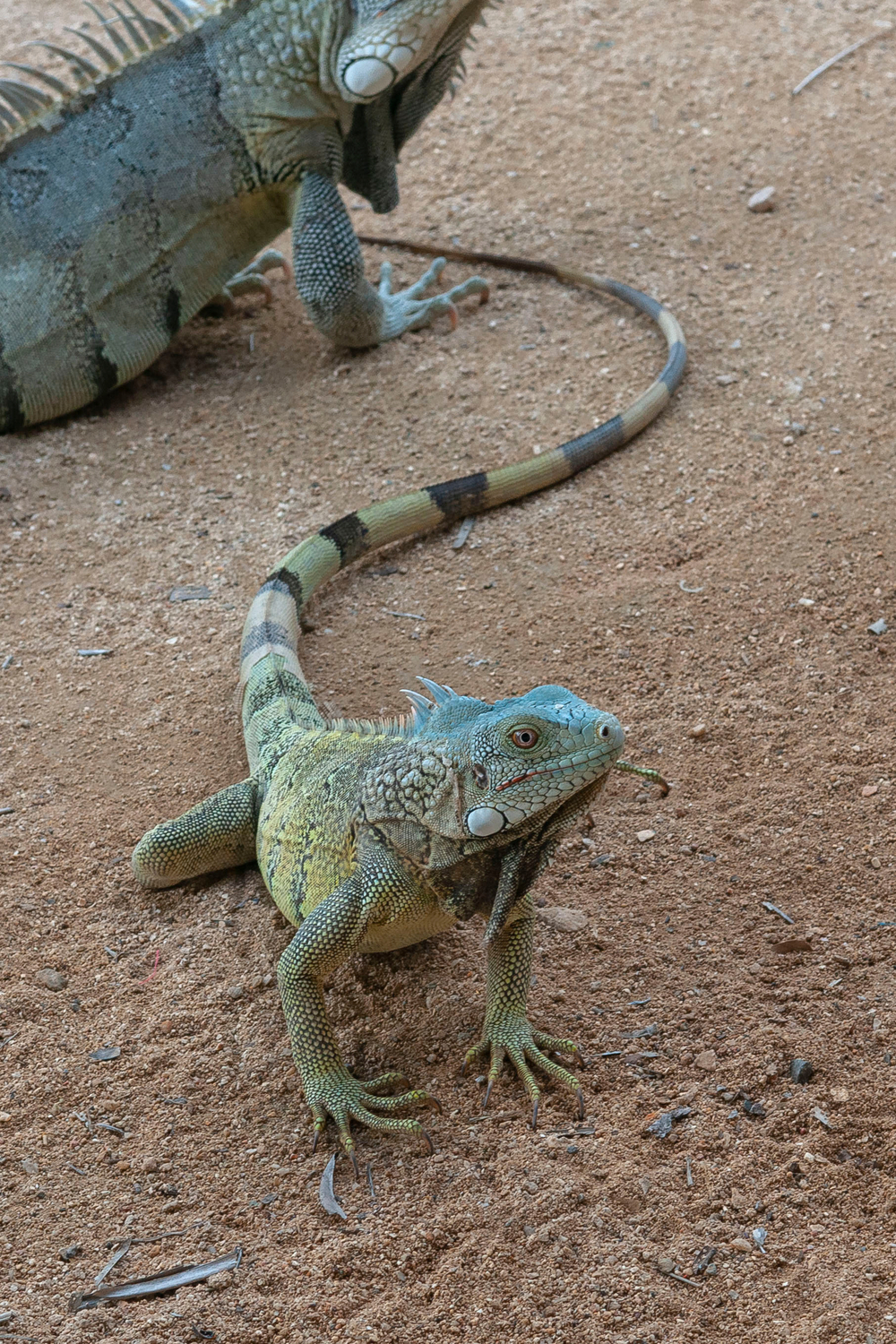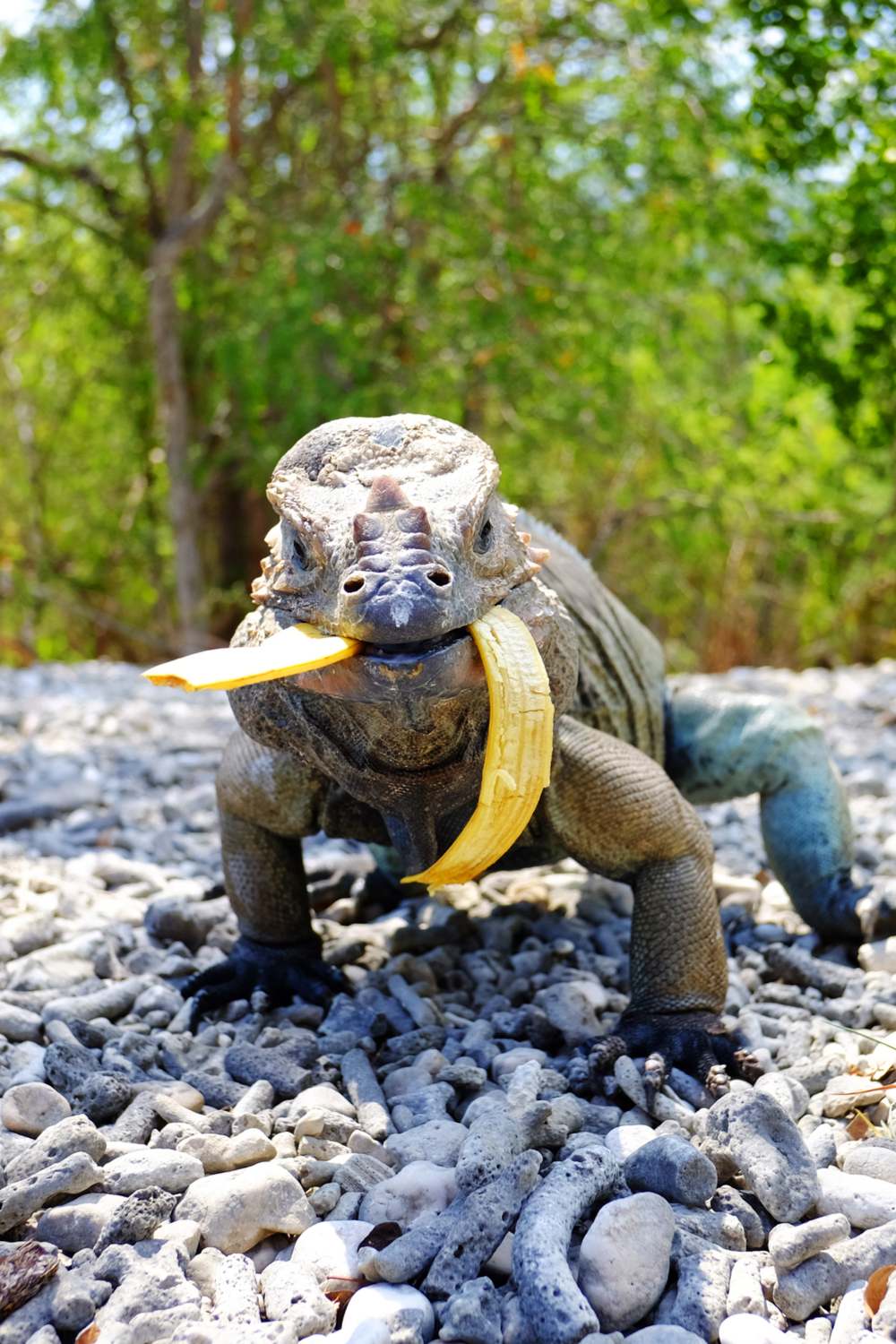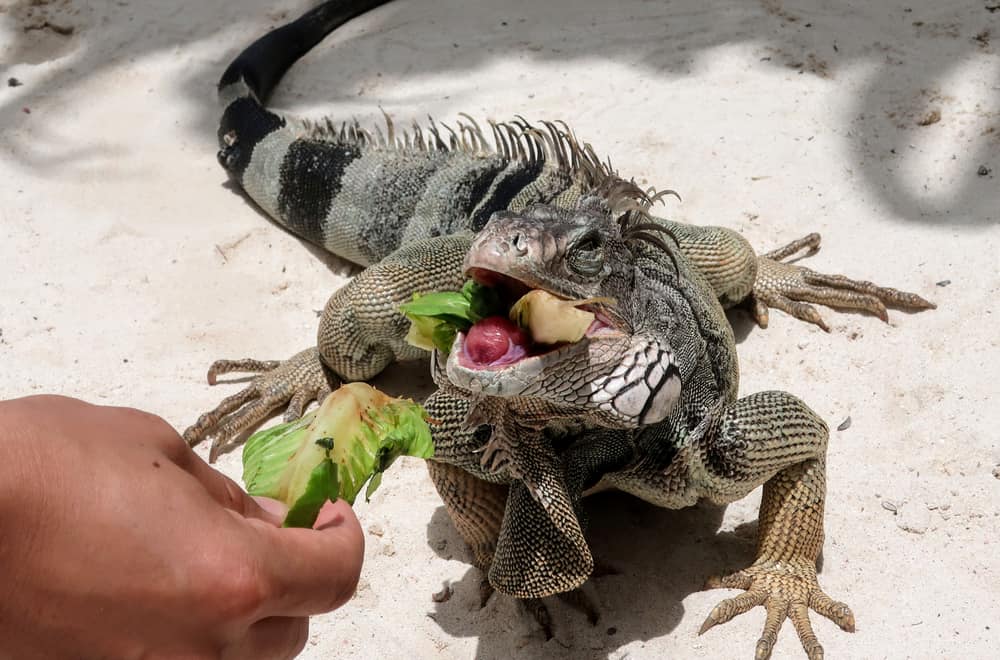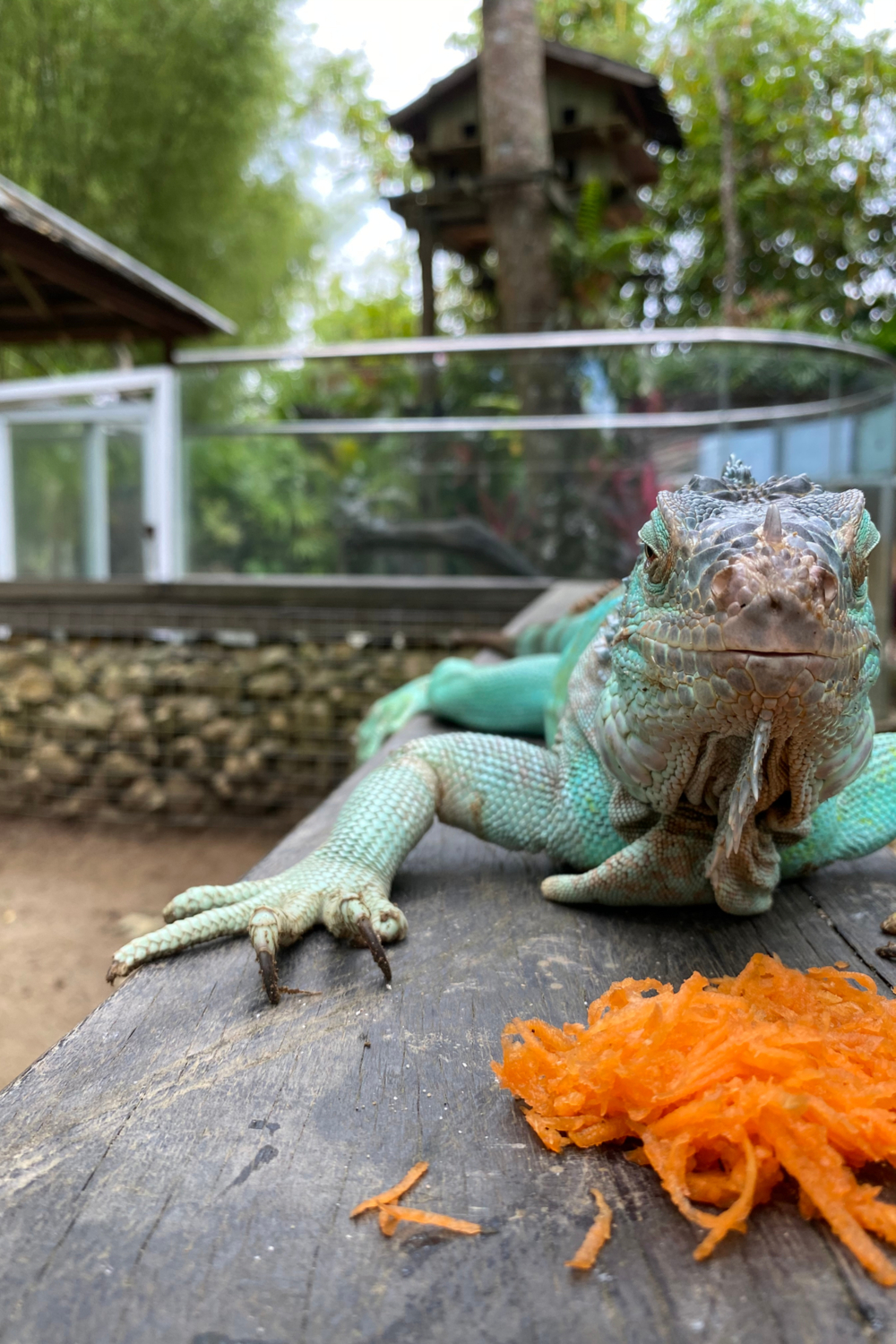Iguanas belong to the group of the largest lizards, but the weird thing is that their tails make at least half of the total body length. These animals are cold-blooded like other reptiles, and they also lay eggs.
Luckily, iguanas can quickly adapt to new environments and are not picky eaters. So, let’s see what do iguanas eat in the wild and as a pet.
Iguanas Habits and Biology
You can recognize two different iguanas species in Southern and Central America, including the Green iguanas, most common in the US, and Lesser Antillean iguana (West Indian iguana), the endemic lizard to the Lesser Antilles.
Iguanas can reach up to 6 feet (1.83 m) in length, measured from head to the top of the tail. In most cases, they weigh from 8 to 17 pounds (3.6 kg – 7.7 kg). These lizards can live from 4 up to 60 years, depending on the species.
Iguanas are also well-known for various body color combinations that usually go from dark grey to pale brown. However, you can find iguanas with bright orange to dull green skin.
Iguana types |
||
| Scientific classification | Lesser Antillean iguana | Green iguana |
| Kingdom | Animalia | Animalia |
| Phylum | Chordata | Chordata |
| Class | Reptilia | Reptilia |
| Order | Squamata | Squamata |
| Suborder | Iguania | Iguania |
| Family | Iguanidae | Iguanidae |
| Genus | Iguana | Iguana |
| Species | Iguana delicatissima | Iguana iguana |
| Subspecies | / | I. i. iguana |
| I. i. insularis | ||
| I. i. melanoderma | ||
| I. i. sanctaluciae | ||
Female iguanas can lay from 5 to 40 eggs per one clutch, depending on the species. Another thing that can significantly vary is the incubation period that usually goes from 65 to 115 days. On the other hand, both species need approximately three years to reach a maturity level.
As I have already mentioned, the Green iguana is the most popular pet lizard in the US. However, you can find these animals in the wild in an extensive range of habitats, including:
- Northern Mexico
- The Caribbean Islands
- Southern Brazil
Most of the time, iguanas live inside the tree canopy and only come down when they need to mate, lay eggs, or pick a different tree. Green iguanas from southern and central America enjoy spending time in the trees. That is a reason for their common names like Chicken of the tree and Gallina de Palo.
Amazingly, iguanas have an extremely tough and strong body and can survive a fall from even 40 feet (12 m) in height. These lizards primarily eat vegetation while hanging on the tree, making them herbivorous.
You can expect iguanas to be mainly active during the day since they enjoy sunbathing in direct sunlight. You can typically find these lizards near water surfaces since they enjoy swimming.
What Do Iguanas Eat in the Wild?
Wild iguanas are deft herbivores that pick out specific food, depending on the species and accessible plants in their environment. They can sometimes eat eggs or insects, but it is a rare scenario.
Green iguanas
Green (American) iguanas are the most well-known iguana found in the US. They are enormous animals that can sometimes grow up to 6 feet (1.8 m) in length and weigh around 20 pounds (9 kg).
Green iguanas are arboreal, meaning they live up high in the canopy of trees for a significant part of their lives. They only sporadically come down to choose another tree for a sitting or when they want to mate and lay eggs.
That implies the most significant part of their feeding source comes from the tree. Even though iguanas are not picky eaters and can consume various greenery, you can expect that each of them has a favorite food. For example, Green iguanas living in Panama like to consume wild plums.
Lesser Antillean iguanas
This iguana type is typically 15.5 inches (39.5 cm) long, but full-grown males are at least 30% longer than females. Interestingly, they have an impressive 31.5 inches (80 cm) long tail.
These lizards typically live in scrub woodlands, mangroves, and rainforests throughout the Caribbean islands, including:
- Guadeloupe and Les Saintes
- Maarten, St. Eustatius, and St. Barthelemy
- Martinique, Dominica, and Anguilla
- La Petite Terre and La Desirade
Unfortunately, it is a critically endangered species. To make things worse, captive breeding is practically impossible since most captive-laid eggs are infertile. In nature, females lay 5 to 30 eggs and bury them underground.
These animals are mainly herbivorous that enjoy consuming leaves, shoots, flowers, and fruits, depending on the season.
What Do Iguanas Eat as Pets?
The most common lizard pet in the US is the Green iguanas. They are strictly herbivorous animals and can be folivore and frugivore, depending on the season and the environment where they live. According to that, you can guess that their diet primarily consists of:
- Leaves
- Weeds
- Flowers
- Fruit
As with any reptile kept in captivity, food quality is crucial to iguanas’ wellbeing. They need to choose between limited options of offered ingredients, so it is down to you to make their diet as healthy and beneficial as possible.
Their feeding is often restricted due to seasonal vegetation varieties. However, there are still many different veggies, fruit, and other vegetation you can offer your pet. The list of food that iguanas can eat is very long, but their favorite ingredients include:
- Spring greens, Dandelion, and Alfalfa
- Ribwort, Chickweed, Bindweed, and Bittercress
- Hawkbit, Mallow, and Hedge-mustard
- Dahlia, Viola, Rose, and Lilac
- Pansy, Snapdragon
- Apple blossom
- Lavender, Nettles, and Hibiscus
- Basil, Oregano, and Water-cress
- Rosemary, Sage, and Mint
- Fuchsia, Nasturtium, and Marigold
- Opuntia and Sow thistle
- Beech leaf, Hazel leaf, and Birch leaf
- Berries
- Lambs lettuce and Pak choi
- Bell pepper
- Pumpkin, Marrow, and Mellon
- Sweet potato, Cucumber, and Carrot
- Parsnip
- Plantain, Mango, Fig, and Papaya
- Florette mix
Keep in mind that iguanas have enjoyed the same diet since their inception. Logically, years of breeding in captivity can never annul their nutrient needs in precisely defined proportions they are used to in the wild.
So, you should ensure that your pet gets a large portion of dull green leafy vegetables or approximately 80% to 90% of each meal. Veggies rich in calcium make the best choice for feeding your iguana.
Therefore, those vegetables should make at least 40% to 50% of the whole diet for an adult Iguana. Other vegetables less rich in calcium but richer in other elements should make around 30% to 40% of the meal.
Never offer your iguana light green vegetables like iceberg and celery because of their low nutritional and vitamin efficiency. As you know, they contain nothing more than water and a few vitamins, which is not good enough for these lizards.
Fruit should make the smallest part of the daily diet or less than 20%. Such food is watery but not so nutritive-rich, so it should be only a snack but never the main meal. Finally, your iguanas will also enjoy a moderate amount of yellow, orange, and red veggies.
Tips to Feed Iguanas
If you own a Green iguana, you presumably spent lots of time reading about the best ways to take care of your pet. Unfortunately, most of the information available on the internet is not very precise and sometimes is even incorrect.
Green iguanas have genuinely specific feeding requirements, and not following those requirements can jeopardize your pet’s health. In fact, most of the problems that vets see in these exotic pets are direct consequences of poor care at home, including an inadequate diet without necessary nutrients.
Iguanas living in the wild choose nothing but leaves and plants to eat whenever possible. They will generally eat several small meals throughout the day, and their regular diet includes food high in fiber and plant protein, with very little fat.
So, the best option is to pick out the same ingredients and offer them to your exotic pet. However, you can also select various types of plant-based food, including those unavailable in iguanas’ natural habitat.
However, following the right proportion of 90% vegetables and less than 20% fruit is crucial. Remember that iguanas usually enjoy sweeter fruit sorts, but this food doesn’t have the required minerals and nutrients they need.
As usual, the best option for your iguana is fresh food. You can also offer frozen food to it, but it is necessary to defrost it on time to prevent health issues. Finally, you can buy canned food in the local pet shop, but it shouldn’t be the food of choice for your lizard.
There is one more thing. Always try to avoid getting your pet used to only a couple of food types. Only that way, it will enjoy a wide range of ingredients and get all the necessary nutrients to stay prosperous and healthy.
Summary
Iguanas are not too different from the other pets you can choose as a four-legged family member, but they are a bit exotic and unusual. These lizards have their needs, and you need to meet them if you want to have a happy and healthy pet. In most cases, it will be enough to provide adequate food and a cozy place for living to make this animal satisfied.
